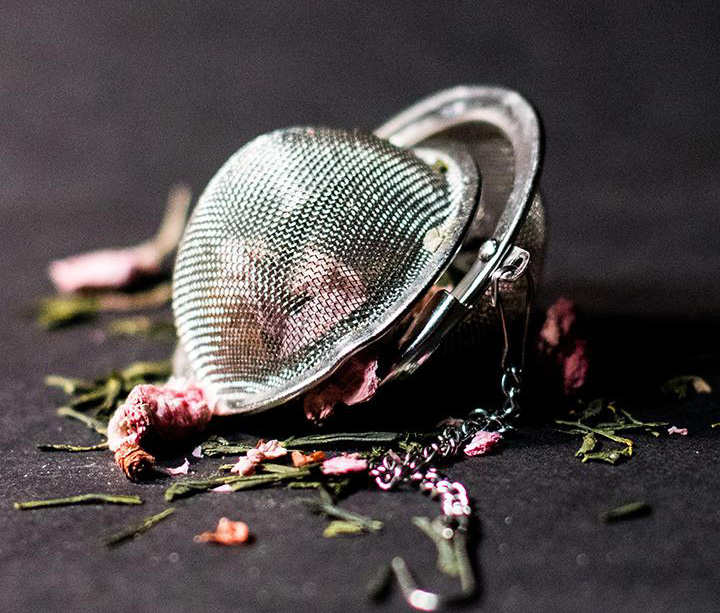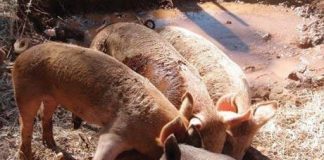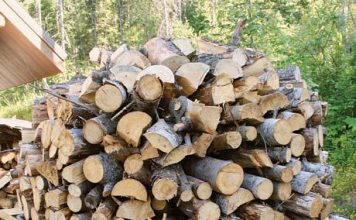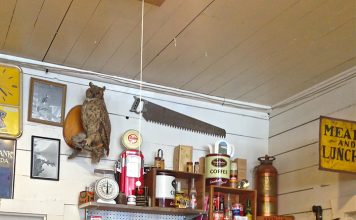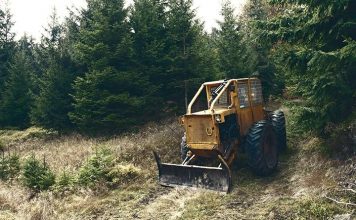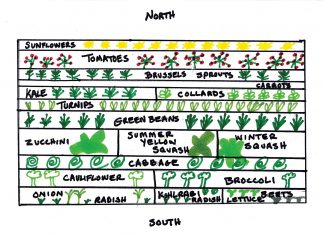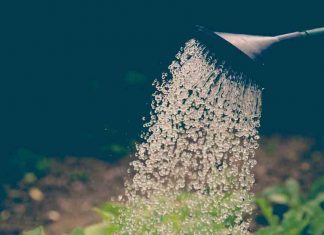| Issue #76 • July/August, 2002 |
The mention of herbal teas brings to mind pleasant conversations in a warmly scented kitchen, aided by the fragrant steam of a cup of Fireweed tea.
Completely aside from tasting great, most infusions of herbs offer a variety of health benefits, ranging from an abundance of naturally occurring vitamins and minerals, to the effects of a broad spectrum antibiotic. There exists an enormous wealth of information covering effects, gathering, drying, storing, and using herbs, but several deserve special mention simply because they are incredibly pleasant to drink. From a purely pleasure seeking point of view, these are the wild herbs you’ll want to know when you venture forth into the wilderness armed with a basket (or two), gloves, an identification book, and a knifeseeking a winters’ supply of nutrition and comfort.
Fireweed
|
(Epilobium Angustifolium) A taste of the Orient. The tea made from the leaves of this very abundant plant is reminiscent of a traditional green tea but with a hint of sweetness. Mild and light yellow-green, this tea is known medicinally for its mild laxative effect. Because it is slightly sweet, it benefits very little from the addition of sugar or milk and is enjoyable, hot or cold, all on its own. Also try fireweed mixed with some of the other tea herbs. Mint, nettle, or chamomile are all tasty blends.
Picking fireweed for tea means finding it before it blossoms, which is in June here in British Columbia. Fireweed grows abundantly in recent burn sites (this is how it got its common name) and other disturbed areas such as clear cuts. It is one of Earth’s natural regenerators, paving the way for the growth of other plants and stabilizing the soil with its creeping roots. Tread lightly and don’t overharvest. Try two in ten plants or less in a locally abundant area and never harvest near a watershed.
Snap the plant off at its base and then strip the leaves. Use fresh or dry leaves for a winter brew. Place one level handful in a warmed teapot or one tablespoon in a cup and pour boiling water over. Steep for five minutes and enjoy.
Raspberry leaf
(Rubus Idaeus) Tangy and fruity well describes the delicious flavor of raspberry leaf tea. Many a mother can extol the pleasures and benefits of drinking honey-sweetened raspberry tea. The trace minerals, high Vitamin C content, and iron in abundance are all wonderful reasons to drink this brewiced, hot, or, as some have found, frozen into popsicles for youngsters seeking a treat. It is also very high in calcium and is an aid in abundant milk production. As if this weren’t enough, raspberry leaf tea is considered by many to be the most enjoyable herbal tea available.
Raspberry is a biennial plant, which means it takes two years to complete its life cycle. In the first year it grows as new, green leafy stalks from the base of the woody mother plant. This new growth is referred to as suckers and should be left alone to mature. The plant to pick leaves from is the thorny, woody stem which will bear fruit this year. The plant will blossom soon after leaf set in May or early June and the best leaves are picked before or during blossoming. However, leaves picked later are perfectly acceptable. Once the fruit is produced, the parent plant begins to visibly die. At this point do not pick any more leaves as the flavor is significantly altered. At all times during the season look for plants and leaves in good condition.
Use the leaves for tea either fresh or completely dry. Raspberry leaves experience a toxic chemical change while drying that makes them poisonous when partially dry or wilted. This is not lethal but will cause uncomfortable nausea and vomiting. They are unquestionably safe for use, even in large quantities, when fresh or entirely dry. Store enough for winter as this is a tea you are sure to love.
Drop a level handful of fresh herb into a warmed teapot and pour boiling water over to fill. Steep for about five minutes or more. Most people find that raspberry tea really benefits from a little honey to sweeten. Always take good care not to crush the dried herb as the flavor is much finer from the intact leaf.
Of course, domestic raspberry leaf has all of the same characteristics of the wild leaf, so if you or someone you know has a patch, go right ahead and use those leaves for tea. In a person’s garden, it is especially important to be sure if any chemicals, including fertilizers, herbicides, or insecticides have been used during the growth of the raspberry plant.
Strawberry leaf
(Fragaria Spp.) Much the same as raspberry leaf in uses, strawberry has a milder, more fruity flavor. The special benefit is that strawberry leaf is one of the highest naturally occurring sources of Vitamin C available. As with raspberry leaf it makes a very pleasant spring tonic and is especially beneficial to pregnant and nursing mothers and to young children. It is very soothing to the stomach.
|
Harvest young leaves, in good condition, throughout the spring and summer, but particularly during blossoming for the finest flavor. Again, use either fresh or completely dried leaves as strawberry leaf suffers from the same toxic change as raspberry leaf during the drying process. Its safety as a tea is not in question when the leaf is entirely dry or fresh but not between the two. Brew the same way as raspberry leaf tea but expect a more complex, fruitier flavor.
Take special care when harvesting because of strawberry’s role as a colonizer and soil stabilizer in newly healing areas. Walk and harvest lightly.
Often strawberry favors poor soil conditions, such as sunny, dry, gravelly, or sandy slopes, where many other plants would not cope well at all. Try to avoid harvest altogether in these areas, and instead harvest in areas with more abundant growth.
Domestic strawberry leaf makes a tea with all of the same properties, though perhaps not as strong. Be sure if harvesting the domestic sort that the patch is free of chemicals.
Stinging nettle
|
(Urtica species) What? Drink that for tea? Are you crazy? Yes, yes, and no. Nettle is a great food and great tea. It lays claim to a huge range of vitamins and minerals including iron, calcium, potassium, manganese, and Vitamins A, C, and D. In fact, nettle is one of the only land-growing plants that can boast of containing Vitamin D. Completely aside from all of that, nettle tea tastes really good.
The difficulty, of course, lies in gathering this notorious plant. Wear good gloves to protect the hands, and do not neglect long sleeves, full pants (not shorts), and proper shoes with socks (not sandals). If this sounds like the voice of bitter experience it’s because it is.
Look in areas with rich soil, deep in damp forests, or in neglected gardens. Nettle gobbles up large amounts of land if the conditions are appropriate and a nettle stand is indicative of well balanced, humus-rich soil in good condition. Indeed, the addition of this plant to the compost heap yields a speedier process and a more balanced end result. A wonderful, all purpose fertilizer can be made from nettle as well. Simply put about one pound of fresh nettle in a five gallon plastic pail and fill with rain water. Let sit. It will smell awful and foam and work for about three weeks. When the action has stopped, strain the liquid and your fertilizer is done. Dilute with 10 parts water to 1 part nettle brew for heavy feeders and about 20 to 1 for regular garden crops like onions and flowers.
Back to tea making. Plants should be 6 to 12 inches tall for the best tea. Cut them off and lay them on racks to dry. The plants can still sting when partially dry so wear gloves when working with them in the kitchen. When the plants are completely dry, strip the leaves off and store in an airtight container. Brew as for strawberry leaf and sweeten to taste with a bit of honey. The addition of a little lemon juice is said to improve the flavor but this seems a bit excessive.
In some places, nettle is considered a noxious weed so be aware if gathering someplace that may have been sprayed. Also consider starting your own nettle patch, tucked away somewhere where it will be left alone to grow and flourish. That way you need never be without this wonderful healthful plant and perhaps you might think to enjoy it as one of the earliest, tastiest spring greens.
Mint
(Mentha Canadensis and others) This tea herb is the basis of some of the most popular herbal teas, and its fame is well deserved. Pungent and aromatic, it is a well documented stomach settler, especially appreciated after over indulging in rich foods. Luckily enough, it is relatively easy to find, identify, and gather. The square stems of the mint family are difficult to mistake, but rubbing the leaves to release the aroma is unmistakable.
|
Look for mint and its relatives in moist riparian areas beside, or sometimes in lakes and rivers. For this reason, it is especially important to gather responsibly as these areas are both the easiest to damage and the hardest to heal.
Use the herb fresh, or dry it enough for winter’s use when a cheery cup, perhaps mixed with pineapple weed, will remind you of summer. Mint is particularly good gathered when it is young, in late spring and early summer, but the harvest can continue as long as you can access your gathering areas.
Should you wish to cultivate your own mint garden, be very aware that it has absolutely no regard for boundaries. Mint is best raised in a pot so that its rapacious growth can be controlled. It is interesting to note that North Americans have only one wild mint, Mentha Canadensis, or Mentha Arvensis, so often the “wild” mint we are gathering is actually domestic mint escaped from captivity. As always, when gathering in a garden, be sure that the mint has not been sprayed with any chemicals.
Pineapple weed
|
Pineapple weed, which is also called false chamomile (Matricaria Matricarioides), is certainly the flower of hope. It is most often seen poking its sunny head from between the sidewalk stones, eager to spread its inviting delicious pineapple scent when stepped on or brushed. Pineapple weed uses and effects are identical to the familiar domestic chamomile (Matricaria Chamomilla) in that it is a mild sedative and soothing to the stomach. Mixed with mint, it makes a relaxing, dreamy tea that a person can’t help but enjoy. The effect is mild enough to be enjoyed by children and it is an especially beneficial herb to new mothers. Indeed, the latin name Matricaria means mother (matri) dear (caria).
Pineapple weed blooms from spring until well beyond frost and is relatively easy to find. Harder though is to find a patch uncontaminated by someone vainly attempting to eradicate this cheery harbinger of calm introspection. As I look out of my window, I see a fine pineapple weed patch. My whole family enjoys this herb so much that we have used it for our lawn. You can buy lawn chamomile from Richters Herbs in Goodwood, Ontario, but it is very easy to naturalize the wild sort.
To gather for tea, it is the flowers you want. These are the yellow buds that look like daisy centers without the rays. Some enthusiasts include the bitter feathery leaves, but this interferes with the gentle, flowery flavor. This must be a matter of personal taste. Try to gather enough for a winter’s supply, but this can be rather difficult as the flowers are so small and the taste so delicious that you will want to drink a great deal. Luckily, it mixes well with other herbs, specifically mint and fireweed.
Spruce bud
(Picea species) It seems incredible that anyone could have suffered from scurvy in a land with such abundant, year-round Vitamin C free for the taking. Here is another tea absolutely stuffed with it. Spruce, pine, and fir all yield a spicy, flavorful, very warming brew from those acid green shoots that spring forth in the early summer, making the whole tree look several shades lighter in color. Having tried spruce, fir, and pine, the finest, mildest tea is made from the bud of the spruce tree. Spruce and fir can be differentiated by the needles. Spruce needles roll easily between the fingers while fir, being flat, do not roll at all. The bud, when young, releases easily from the tree.
|
When you harvest the young buds, you are taking this year’s growth, so be gentle. Pretend you are a grazing deer and take a nibble here and a nibble there and then move on to the next tree. Never harvest the topmost growth as this will cause the tree to grow two tops and effectively weaken it. Evergreen trees are rich in vitamins, particularly Vitamin C, which makes this especially valuable since it is available year-round. The buds can be dried for winter use but this is unnecessary. Although the new growth yields the mildest tea, the spruce tips can actually be harvested all year. Indeed, some people prefer the stronger, spicier tea from the winter spruce tips.
Use one teaspoon of fresh herb for each cup. Pour boiling water over it and let it steep for about five minutes. This yields a strong tea so adjust it to your liking. This tea seems to call for a blazing fire and a plate of ginger cookies and is a perfect tea for a cozy winter night.
Tea gathering, just like tea drinking, can be comforting, warming and relaxing, or exhilarating, uplifting and refreshing. It is always enjoyable and it is a wonderful excuse to get out and enjoy your natural surrounding. Gathering herbal teas gives one time to think about things. It is a good time to reflect upon our place on the Earth and to remember that we are not the only species who rely on the natural balance. Wildcrafters can do a lot of damage to the areas in which they harvest. Goldenseal and ginseng in the wild are, for the most part, a thing of the past. But harvesting conscientiously will ensure a future full of herbal teas and wild foods.
An herbal addendum
This article speaks from a large amount of personal experience. However, not everyone can have a full laboratory in their home. A good identification book is a must for wildcrafting. There are so many that a list would be futile. Find one that you are happy with and that is appropriate for your area and climate. Beyond that, it is a good idea to have, or have access to, several herbals. Several because you may wish to cross reference information. In the box I have listed some valuable resources which have become my personal favorites. They were all drawn upon for the compilation of this article. All are fairly complete and each has a unique point of view.
This article, in turn, is a rewritten excerpt from my own booklet, Popular Circumpolar Tea Herbs.
ResourcesFrom Earth to Herbalist by Gregory L. Tilford, 1998Edible Medicinal Plants of the West by Gregory L. Tilford, 1997 Discovering Wild Plants by Janice J. Schofield, 1989 Edible and Medicinal Plants of the Rocky Mountains and Neighbouring Territories by Terry Willard, Ph. D., 1992 Wise Woman Herbal for the Child Bearing Year by Susan S. Weed Wild Coffee and Tea Substitutes of Canada by Nancy Turner and Adam Szezawinski, National Museum of Natural Sciences, 1978 Plants of Northern B.C. by Mackinnon, Pojar, and Coupé, 1992 Harvesting the Northern Wild by Marilyn Walker, 1984
|


